2012年04月20日
M26 MASS Shotgun
私たちのブログを訪問していただきありがとうございます。あなたがお持ちの場合DIYの要求は私達に電子メールを送信してください。
M26 MASS shotgun Issued to members of 101st Airborne Infantry Division

The 502nd Parachute Infantry Regiment (a.k.a. 2nd BCT/101st Airborne Infantry Division) is the first unit to field the M26 Modular Accessory Shotgun System. According to a story on ClarksvilleOnline.com, Strike Brigade’s engineers and military police with H&H were trained up over three days by members of Picatinny Arsenal’s PM Soldier Weapons after a ceremony held Feb. 7, 2012, at Ft. Campbell, Kentucky.
The MASS is designed to aid in faster transitions from the shotgun to the rifle during breaching operations, but has other applications including less-than-lethal rounds. It mounts beneath the barrel of an M4 and can be attached to a stock and used as a standalone shotgun. It is a 12-gauge system and has a five round magazine.
By Rob Curtis, miitarytimes
BLOG ARCHIVES

M26 MASS shotgun Issued to members of 101st Airborne Infantry Division

The 502nd Parachute Infantry Regiment (a.k.a. 2nd BCT/101st Airborne Infantry Division) is the first unit to field the M26 Modular Accessory Shotgun System. According to a story on ClarksvilleOnline.com, Strike Brigade’s engineers and military police with H&H were trained up over three days by members of Picatinny Arsenal’s PM Soldier Weapons after a ceremony held Feb. 7, 2012, at Ft. Campbell, Kentucky.
The MASS is designed to aid in faster transitions from the shotgun to the rifle during breaching operations, but has other applications including less-than-lethal rounds. It mounts beneath the barrel of an M4 and can be attached to a stock and used as a standalone shotgun. It is a 12-gauge system and has a five round magazine.
By Rob Curtis, miitarytimes
BLOG ARCHIVES

2012年04月19日
Ruger S R-556E 5.56mm
私たちのブログを訪問していただきありがとうございます。あなたがお持ちの場合DIYの要求は私達に電子メールを送信してください。
Essential duty/patrol AR — everything you need and nothing you don’t!

The Ruger SR-556E, despite its piston-operated upper receiver, employs a standard lower receiver with traditional AR controls in the familiar locations.
I think it would be fair to name the current times the “Age of the AR-15.” Few weapon platforms currently enjoy the popularity of the AR, with models and variants continuously being introduced by multiple manufacturers. In reality, these models are nothing more than hardware modifications with varied accessories such as stocks, grips, sights, forends and the like being swapped about with the guts of the platform remaining the same. There isn’t really much that can be changed to the basic design beyond making it a gas piston operation in direct opposition to the somewhat dirty direct gas function. Though, in all fairness, the direct gas impingement action has been perfected and works just fine. So what does a company add to their product line once they have produced a popular model? How about offering it at a reduced cost? That is exactly what Ruger has done with their extremely popular SR-556 gas piston rifle, and I believe they may be on to something here.

Ruger SR-556E offers the same internal features that made the original Ruger SR-556 a success, but it is a more basic configuration with a simplified forend and A2-style pistol grip. Shown here with Aimpoint CompM4s and Troy BattleSights.
If you take a moment to study the AR-15 phenomenon, the whole “It’s Barbie for men” joke is really not that farfetched. Please understand, I am not making fun of anyone here—I’m just as guilty as the rest for trying different equipment options for my AR. Is this really any different than trying various holsters, magazine pouches and other related gear to find the best daily carry set up? I think not! Where it becomes absurd is adding gadgets to the gun for the “cool factor” with no realistic, foreseeable problem being solved. If you have hung an accessory on your gun for no other reason than “it looks cool,” you have missed the point of the exercise.

The SR-556E employs an effective multi-stage regulator system with a knurled adjustment knob on the forward face of the gas block.
Ruger looked at what accessories well-informed end users purchased for their gun and decided to let them choose what was best on an SR-556. Thus, the SR-556E (Essential) is a carbine shipped from the factory with only those essential features you need to build your gun the way you want it. By doing so, Ruger is able to reduce the cost of the gun, which will lead some to believe that “E” stands for economy.

Rather than using a more common A2-style birdcage flash suppressor, the SR-556E employs a classic Ruger-style slotted suppressor on its threaded muzzle.
By Dave Spaulding, Images by Sean Utley
BLOG ARCHIVES

2012年04月19日
Nighthawk Tactical 6.5-.284 RIFLE
私たちのブログを訪問していただきありがとうございます。あなたがお持ちの場合DIYの要求は私達に電子メールを送信してください。
Wily wildcat cartridge and custom platform makes it the Lamborghini of sniper rifles!

If you need a cutting-edge custom precision rifle capable of putting lead on target at 1,000 yards and beyond, the Nighthawk Tactical Rifle in 6.5-.284 should fit the bill superbly.
It seems that just about every tactical rifle built these days is chambered in the ubiquitous .308. I understand the allure of the cartridge from a logistical perspective. It’s everywhere — you can find .308 ammunition at the corner drug store, under the seat of most pick-ups and at just about every law enforcement agency/military organization in the United States of America. While it is easy to find and some of the least expensive ammunition out there, the .308 is a ballistic pig. Compared to some of the other cartridges available to today’s shooter, the .308 is about as aerodynamic as a bowling ball.
Gasp! How dare a gun hack blaspheme our nation’s pet tactical cartridge of choice! I didn’t say that I hated the .308, I’m saying I don’t “love” it. The .308 is a fine choice for short-range work and really offers a lot for marksmen shooting out to 600 meters. The short action is nice for rapid bolt work and the .308 is easy on barrels. However, if you want to shoot farther than 600 meters or so, there are many calibers that would make a better choice. One of my favorites is the 6.5-.284, the cartridge chambered in the Nighthawk Tactical rifle here.
Cartridge Details
The 6.5-.284 started off as a wildcat cartridge from its parent, the .284 Win. Necking the .284 down to 6.5mm proved to be a winning combination for long-range enthusiasts searching for mild recoil, high muzzle velocities and high ballistic coefficients. The 6.5-.284 proved to have all three in spades and has become the darling of serious long-range shooters for almost a decade.
The reason the 6.5-.284 is such an excellent choice for long range shooting is that it combines high muzzle velocity with exceptional ballistic coefficients. The higher the muzzle velocity of a cartridge, the flatter it will shoot. A flat shooting rifle is more forgiving to a sniper who fudges his range estimation because the flatter the trajectory of the bullet means that the bullet flies closer to the sniper’s line of sight. In a perfect world, bullets would fly along the line of sight and we wouldn’t even need to estimate range. Alas, we live in a world of gravity where bullets have to be lobbed to their targets. The less parabolic the lob, the less precise we have to estimate our range. Flatter trajectory is always better. The 6.5-.284 has, on average, a 300 feet per second (fps) faster muzzle velocity than the .308.
Where the 6.5-.284 really makes me weak in the knees is when we start looking at its ballistic coefficient (BC). 6.5mm bullets commonly fired in the 6.5-.284 have ballistic coefficients from .595 - .627. BCs of the .308 hover between .488 and .505. While it might not look like much, the higher BC of the 6.5-.284 offers a tremendous advantage to the long-range shooter. The higher BC bucks the wind better, so the sniper has a greater margin of error with his wind calls. For example, the .308 rifle I was issued when I was in the service would have required 7.6 minutes of correction for a 10 mph wind at 900 meters. This Nighthawk Tactical rifle featured here would have only required 5.6 minutes of correction. As a rule, the more aggressive a correction required to compensate for the wind, the higher a probability of a botched wind call.

Nighthawk Tactical has been making custom 1911s for a long time now and has earned the reputation of being one of the finest manufacturers available. They recently started making tactical rifles and, from what my experience has been with this rifle, they’ll soon be known for their quality custom rifles as well.
By Tom Beckstrand, Images by Ichiro Nagata
BLOG ARCHIVES

2012年04月19日
Panteao’s Colt Model of 1911 - “100 Years of Service”
私たちのブログを訪問していただきありがとうございます。あなたがお持ちの場合DIYの要求は私達に電子メールを送信してください。

The brainchild of John Browning, the Model of 1911 is the most widely copied handgun design in firearms history. Today virtually every major firearms manufacturer offers a version of it. Colt, however, is the only manufacturer to produce the 1911 continuously since its adoption by the US Army on March 29, 1911.
The Colt 1911 saw service in World War 1, World War 2, Korea, and Vietnam. Specialized units of our military continued to use the 1911 in Operation Desert Storm and even today it is seeing action in the hands of our troops in Iraq and Afghanistan. The 1911 celebrates 100 years of continued production and service.

BLOG ARCHIVES

2012年04月19日
Savage Model 110 BA .338 LAPUA MAG
私たちのブログを訪問していただきありがとうございます。あなたがお持ちの場合DIYの要求は私達に電子メールを送信してください。
Blasting through barriers when deployed in an over-watch, perimeter security or countersniper operations!

Savage Arms 110 BA in .338 Lapua bridges the gap between the 7.62mm NATO and .50 BMG with an innovative and state-of-the-art bolt action rifle that delivers the goods in terms of both accuracy and terminal ballistics.
Savage has a long history of manufacturing affordable bolt-action rifles that are reliable and accurate. Most often considered a company that manufactures hunting rifles, Savage also offers tactical-style rifles specifically suited to the law enforcement and military community. It’s true that Savage rifles cost a bit less than some of the competition, but Savage has never taken a back seat to any company when it comes to reliability, innovation and accuracy when it comes to their rifles.
The latest tactical offering from Savage is the Model 110 BA, considered the flagship of their Law Enforcement Series. It is available in two chamberings; .300 Win Mag and .338 Lapua Mag.

The 110 BA comes standard with Savage’s amazing AccuTrigger, which broke at exactly 2 pounds every time with no take-up. The center, actuation lever provides just enough resistance as you take up the slack in it to let you know when the trigger will break.
The Savage .338 Lapua is a big rifle. It weighs over 15 pounds and is just shy of 51 inches long. You would have to be on some strong prescription medication to not look at this rifle and have wickedly tactical thoughts. It looks more like something from some commando movie than what you would expect from Savage. The appearance of the rifle was not devised to get your attention; it is the culmination of a variety of features perfectly suited to tactical application and deployment.

The uniquely designed optics rail, exquisite AccuTrigger and oversized tactical-style bolt handle makes the 110 BA .338 Lapua a top-notch precision tactical rifle.
For starters, the 110 BA’s stock is an all-aluminum AccuStock. The forearm is nothing more than an aluminum, U-shaped channel that bolts to the AccuStock where the action is solidly secured both laterally and horizontally. There is so much space around the barrel there is no way the forearm will ever come into contact with it. At the muzzle end of the forearm there are three sling swivel studs; one on each side and one on the bottom.
By Richard Mann, Images by Ichiro Nagata
BLOG ARCHIVES

2012年04月19日
Zel Custom Tactilite .338 Lapua
私たちのブログを訪問していただきありがとうございます。あなたがお持ちの場合DIYの要求は私達に電子メールを送信してください。

Capitalizing on the well-documented field success of the .338 Lapua Mag, Zel Custom offers their Tactilite upper receiver, shown here on a C3 Defense AR lower. The hyper-accurate .338 is proving to possess outstanding anti-personnel capabilities at jaw-dropping ranges in excess of 1,500 meters.
If nothing else, the Global War on Terror has provided an excellent proving ground for testing guns and gear, thus determining what really works. A few weeks before beginning this review, a British Army sniper in Afghanistan set a new long distance sniper record by killing not one, but two enemy combatants at a distance of 8,120 feet (verified with GPS). The previous record, held by a Canadian sniper, was 7,972 feet. What cartridge did the Brit sniper use to break the record? Nope, it wasn’t the .50 BMG — it was the .338 Lapua.
Officially designated by the manufacturer as the “.338 Lapua Magnum,” the cartridge has actually been in the developmental stages since the early 1980’s. The .338 Lapua was spawned at the request of the U.S. Military for a long-range sniper cartridge, with the need for a round to be effective at distances up to 1,500 meters.
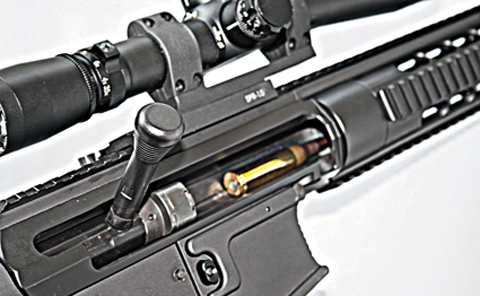
Made from 4340 alloy steel, the Tactilite bolt retracts into the vacant buffer tube. Rounds are loaded singly into breech via a push-feed mechanism.
While it might not have the equipment-crushing power of the .50 BMG, the .338 Lapua using 250- and 300-grain projectiles has serious long-range anti-personnel capabilities. Ballistic coefficient numbers are impressive. The 250-grain BTHP has a 0.61 BC and the 300-grain calculates to 0.73. By comparison the 175-grain .30 caliber BTHP is 0.54 BC. Before getting buried in numbers, it helps to take a look at the hardware.
Question: What is the most versatile rifle available today? Answer: The AR-15 and its myriad clones. Hundreds of thousands of AR variants are in circulation. Dovetailing with the popularity and success of the “black rifle,” Zel Custom Manufacturing is offering specially designed upper receivers in several large rifle calibers.
The initial offering from Zel Custom was the Tactilite T1 in .50 BMG. I had the opportunity to work with one of these rifles last year and found it to be a quality item. Zel surveyed the market and asked the public what caliber they’d like to see next, and the overwhelming response from the public was the .338 Lapua.
By Paul Markel (tactical-life)
BLOG ARCHIVES


Capitalizing on the well-documented field success of the .338 Lapua Mag, Zel Custom offers their Tactilite upper receiver, shown here on a C3 Defense AR lower. The hyper-accurate .338 is proving to possess outstanding anti-personnel capabilities at jaw-dropping ranges in excess of 1,500 meters.
If nothing else, the Global War on Terror has provided an excellent proving ground for testing guns and gear, thus determining what really works. A few weeks before beginning this review, a British Army sniper in Afghanistan set a new long distance sniper record by killing not one, but two enemy combatants at a distance of 8,120 feet (verified with GPS). The previous record, held by a Canadian sniper, was 7,972 feet. What cartridge did the Brit sniper use to break the record? Nope, it wasn’t the .50 BMG — it was the .338 Lapua.
Officially designated by the manufacturer as the “.338 Lapua Magnum,” the cartridge has actually been in the developmental stages since the early 1980’s. The .338 Lapua was spawned at the request of the U.S. Military for a long-range sniper cartridge, with the need for a round to be effective at distances up to 1,500 meters.

Made from 4340 alloy steel, the Tactilite bolt retracts into the vacant buffer tube. Rounds are loaded singly into breech via a push-feed mechanism.
While it might not have the equipment-crushing power of the .50 BMG, the .338 Lapua using 250- and 300-grain projectiles has serious long-range anti-personnel capabilities. Ballistic coefficient numbers are impressive. The 250-grain BTHP has a 0.61 BC and the 300-grain calculates to 0.73. By comparison the 175-grain .30 caliber BTHP is 0.54 BC. Before getting buried in numbers, it helps to take a look at the hardware.
Question: What is the most versatile rifle available today? Answer: The AR-15 and its myriad clones. Hundreds of thousands of AR variants are in circulation. Dovetailing with the popularity and success of the “black rifle,” Zel Custom Manufacturing is offering specially designed upper receivers in several large rifle calibers.
The initial offering from Zel Custom was the Tactilite T1 in .50 BMG. I had the opportunity to work with one of these rifles last year and found it to be a quality item. Zel surveyed the market and asked the public what caliber they’d like to see next, and the overwhelming response from the public was the .338 Lapua.
By Paul Markel (tactical-life)
BLOG ARCHIVES

2012年04月18日
Mark 47 Mod 0 Striker 40mm
私たちのブログを訪問していただきありがとうございます。あなたがお持ちの場合DIYの要求は私達に電子メールを送信してください。
New full-auto grenade launcher system with target acquisition and ranging technology!
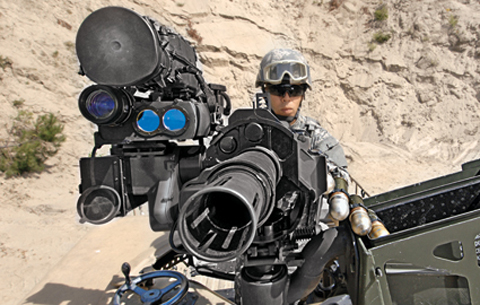
The Mk 47 Mod 0 40mm ALGL mates to a high-tech integrated target acquisition and ranging system as well as with HEAB ammo to become a new order of weapon that not only delivers first-round hits, but can deliver PP-HE/SD aerial burst rounds as well.
From the first rock or stick thrown, either at an adversary or at a creature that looked like food, the object of projectile or missile weapons has been to put destructive energy on the target. Until the advent of gunpowder, it was merely the weight and mass of the projectile transferring kinetic energy to the target. But as soon as it was discovered that an exploding projectile or missile could additionally carry chemical energy to the target, exploding missiles were used, followed by cannon with bursting projectiles. Of course both these methods are still used today.
Carrying kinetic energy to the target requires a projectile with both mass and velocity, which requires a strong and therefore heavy launch system, whose weight rises exponentially with the mass and velocity of the projectiles used. This reality has tended to limit kinetic energy rounds to small arms at one end of the scale or anti-armor artillery pieces at the other.
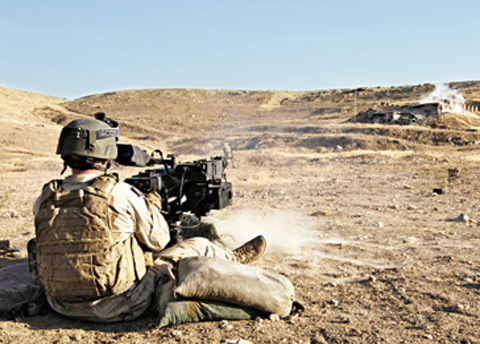
A SpecOps trooper gets familiar with the Striker 40mm as it was first deployed to the sandbox. The integrated target acquisition technology delivers the rounds just behind what would ordinarily provide cover.
The advantage of the larger shell is that it can carry a lot of chemical (explosive) energy in addition to its kinetic energy. What has always been needed is a system for Infantry that would deliver usable chemical energy at infantry ranges. First came hand-thrown grenades (the name coming from the pomegranate, which the early ones resembled); then came rifle adapters to throw specialized grenades farther and more accurately. Finally in the late 1950s were fielded dedicated grenade launchers in the form of the M79 “Bloop” gun that fired a self-contained cartridge with explosive projectile. This idea worked so well, it was soon followed by various crew-served belt-fed versions with similar projectiles, such as the preeminent Mk 19, which has been copied, licensed and imitated with varying degrees of success.
By F.W. Demara
BLOG ARCHIVES

New full-auto grenade launcher system with target acquisition and ranging technology!

The Mk 47 Mod 0 40mm ALGL mates to a high-tech integrated target acquisition and ranging system as well as with HEAB ammo to become a new order of weapon that not only delivers first-round hits, but can deliver PP-HE/SD aerial burst rounds as well.
From the first rock or stick thrown, either at an adversary or at a creature that looked like food, the object of projectile or missile weapons has been to put destructive energy on the target. Until the advent of gunpowder, it was merely the weight and mass of the projectile transferring kinetic energy to the target. But as soon as it was discovered that an exploding projectile or missile could additionally carry chemical energy to the target, exploding missiles were used, followed by cannon with bursting projectiles. Of course both these methods are still used today.
Carrying kinetic energy to the target requires a projectile with both mass and velocity, which requires a strong and therefore heavy launch system, whose weight rises exponentially with the mass and velocity of the projectiles used. This reality has tended to limit kinetic energy rounds to small arms at one end of the scale or anti-armor artillery pieces at the other.

A SpecOps trooper gets familiar with the Striker 40mm as it was first deployed to the sandbox. The integrated target acquisition technology delivers the rounds just behind what would ordinarily provide cover.
The advantage of the larger shell is that it can carry a lot of chemical (explosive) energy in addition to its kinetic energy. What has always been needed is a system for Infantry that would deliver usable chemical energy at infantry ranges. First came hand-thrown grenades (the name coming from the pomegranate, which the early ones resembled); then came rifle adapters to throw specialized grenades farther and more accurately. Finally in the late 1950s were fielded dedicated grenade launchers in the form of the M79 “Bloop” gun that fired a self-contained cartridge with explosive projectile. This idea worked so well, it was soon followed by various crew-served belt-fed versions with similar projectiles, such as the preeminent Mk 19, which has been copied, licensed and imitated with varying degrees of success.
By F.W. Demara
BLOG ARCHIVES

2012年04月18日
B&T APC9 Civilian Model
私たちのブログを訪問していただきありがとうございます。あなたがお持ちの場合DIYの要求は私達に電子メールを送信してください。
Brügger & Thomet is now selling in Europe a semi-automatic civilian-legal version of the 9mm B&T APC9 submachine gun which they unveiled last year. A TFB reader in the Czech Republic took these great photos of the new gun…
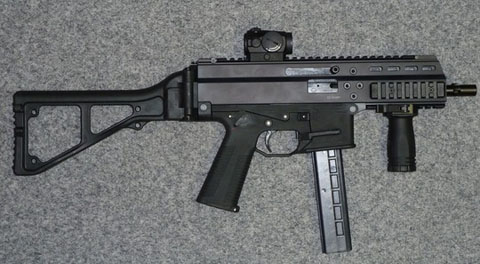








By Steve, thefirearmblog
BLOG ARCHIVES

2012年04月18日
Sako TRG-42 .338 Lapua Mag
私たちのブログを訪問していただきありがとうございます。あなたがお持ちの場合DIYの要求は私達に電子メールを送信してください。
A lightweight and adaptable sniping system that goes beyond 1,750 meters!

Sako’s TRG-42 .338 Lapua Mag gives long-range snipers a highly precise, suppressed bolt-action rifle ready for action. It is topped off with a Schmidt & Bender PM II 5-25×56mm scope.
The sniping caliber of choice for many special operations units today has become .338 Lapua Mag. Incredibly accurate at ¼-MOA or better, sniping rifles in this caliber weigh only a pound or two more than .308 sniping rifles and allow special ops snipers to reach out to more than twice the distance and hit with substantially more power. Since special operators are normally tasked with acting as force multipliers, the advantages of the .338 round are highly valued. The availability of folding stocks for the two or three most popular special ops .338 Lapua rifles allows them be even more portable when deployed from helicopters, small boats, or by foot.
The most widely used .338 Lapua loads can push a 250-grain bullet 2,950 fps (feet per second) and produce 4,800 fpe (foot-pounds of energy). At 1,000 meters, a .338 Lapua bullet could still penetrate five layers of military body armor. Maximum effective range of the round is usually given at 1,750 meters, but it has been used at even greater ranges. Despite being a high-performance sniping cartridge, the .338 Lapua round does not actually cause as much barrel wear as some other cartridges — an important consideration in a sniping rifle, since good snipers practice a lot.

The buttstock is fully adjustable for cheek height, length of pull and pad position. It also contains an integral monopod to complete the support of the rifle for precision shot placement. A simple but rock-solid hinge system locks the folding stock into the extended or collapsed position.
I have now done a reasonable amount of shooting with the four .338 sniping rifles most widely used by special operators and like some aspects of each of them, But Sako’s TRG-42 is truly an outstanding rifle. Many anti-terrorist units around the world use it; among the countries that assign the TRG-42 to their special ops units as their .338 Lapua sniper rifle are Albania, Denmark, Finland, Estonia, Greece, Italy, Russia, Spain, Switzerland, and Turkey.
The .338 Lapua TRG-42 model tested is the OD (Olive Drab/ green), folding stock variant, which is the model used by most units. Black and OD/green fixed stocks are also available. The 27.13-inch tapered, target-grade, chrome moly barrel is cold hammer forged for toughness and accuracy. It has a black phosphate finish. The barrel is threaded for a muzzle brake. Note that the threaded barrel will also take a suppressor. Twist in .338 Lapua is 1-in-12 inches, a rate considered optimum for the 250-grain load used by most military snipers. Overall length with the stock deployed is 49.75 inches and with the stock folded 40.25 inches. Lengths are with muzzle brake installed.

The aggressive muzzle brake helped to tame the felt recoil of the .338 Lapua Mag.
It weighs about 17.5 pounds with the scope and bipod attached, which keeps the TRG-42 portable enough that an operator can transport it into a shooting position quite readily. Note that in comparisons based on published weights for the fixed stock TRG-42, the folding stock version is actually heavier. Yet the TRG-42 is still a couple of pounds lighter than competitive .338 Lapua sniper rifles even with the folding stock.
By Leroy Thompson
BLOG ARCHIVES

2012年04月18日
Optimum Tac Scopes
私たちのブログを訪問していただきありがとうございます。あなたがお持ちの場合DIYの要求は私達に電子メールを送信してください。
Without proper glass, even the most high-end precision rifle is a worthless club in combat!
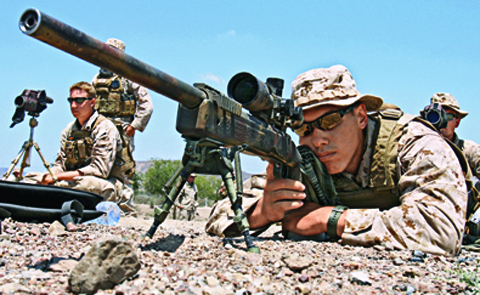
U.S. Marine Corps Sgt. Tim R. Lee, with Scout Sniper Platoon, Headquarters and Support Company, Battalion Landing Team, 1st Battalion, 9th Marine Regiment, 24th Marine Expeditionary Unit (MEU), fine tunes the sights of his M-40 sniper rifle before the first stage of a three-day platoon competition in Djibouti March 25, 2010. The contest challenges scout snipers in communication, marksmanship and teamwork during competitive relays. The 24th MEU is on a seven-month deployment aboard Nassau Amphibious Ready Group vessels as the theater reserve force for Central Command. (U.S. Marine Corps photo by Sgt. Alex C. Sauceda/Released)
With the popularity of tactical precision rifle shooting on the increase, it naturally follows that new participants want to get the most from their choices. While rifle selection is without a doubt a top priority, choosing a tactical scope is nearly as important. In fact, it’s so important that it literally controls how effective both the rifle and its operator will be.
When the newcomer first peruses the mind-boggling array of tactical scopes currently available, he more often than not finds himself, “on the horns of a dilemma.” Small wonder — there are so many different types and designs being offered these days. So many, in fact, that even the more experienced tactical precision rifle shooter can find himself confused as to which one is best for his needs.
After spending a sizeable chunk of money on a factory or custom-made rifle, the shooter also crashes into the fact that any tactical scope worth having isn’t going to be cheap. Thus, he needs to resign himself to spending a bit more to get the best scope he possibly can.
By Chuck Taylor, Images by DoD Photo
BLOG ARCHIVES

2012年04月17日
DEL-TON M16A4 5.56mm
私たちのブログを訪問していただきありがとうございます。あなたがお持ちの場合DIYの要求は私達に電子メールを送信してください。
Based on the U.S. Marine’s battle rifle — a serious rifle with a Devil Dog’s bite!

Del-Ton put together a civilian legal version of the M16A4 rifle, modeled after the preferred battle rifle of the United States Marine Corps. The M16A4 is a serious rifleman’s tool, and to genuinely appreciate its merits a shooter must be trained in the art of the rifle—concepts familiar to any Marine. The 20” barrel is fitted with a NATO-spec “birdcage” muzzle brake/flash suppressor.
United States Marines are a stubborn lot, a fact that has served them well in defending this nation for the last 200-plus years. Case in point, when the U.S. Army was racing to change over to the M4 carbine, the Marines clung to their M16A2 rifles. After the attacks on 9/11 and the beginning of the Global War on Terror, the Corps relented a bit and authorized an improved/upgraded version of their beloved M16A2.
The Colt manufactured M16A4 rifle is a select-fire, or BATFE Class III weapon—making it a bit difficult to come by for those outside of military channels. Understanding that fact, I went for the next best thing. Del-Ton Incorporation (DTI) put together a civilian-legal version of this rifle for me to review herein.

The fixed carrying handle has been replaced by a flattop receiver with removable handle, which allows for the mounting of the Marine version of Trijicon’s ACOG sight
As you would expect, the primary difference is the lack of a three-position selector lever. This Del-Ton rifle has only two settings— safe and “kill,” as my leatherneck brothers like to say. Aside from that fact, the DTI version is a pretty faithful replica.

SureFire’s Vertical Foregrip LED WeaponLight M900V has right and left pressure switches with a positive on/off switch located at the base.
Starting at the top, the fixed carrying handle (don’t every let a Drill Instructor see you using it as one) has been replaced by a flattop receiver with removable carrying handle. The Corps also authorized the replacement of the standard plastic handguards with an aluminum 4-way rail system. This rail system allows the addition of battlefield-critical gear, such as visible and IR laser target designators, vertical grips (not critical but useful) and white/IR combat lights. The standard A2 front sight housing is still present with ¼-click adjustable front sight post.
By Paul Markel, Images by Steve Woods
BLOG ARCHIVES

2012年04月17日
G.A. Precision 6.5 Creedmoor
私たちのブログを訪問していただきありがとうございます。あなたがお持ちの場合DIYの要求は私達に電子メールを送信してください。
Maximizing the cartridge’s effectiveness for all tactical sniper applications!
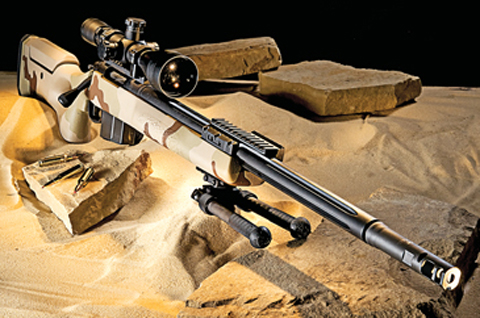
The G.A. Precision rifle is based on a Remington 700-style action in 6.5 Creedmoor caliber and has all of the features wanted in a tactical-grade precision rifle, including a SureFire compensator/suppressor adapter and Manners composite stock.
A new generation of long distance rifles is cropping up that are designed to perform from 500 to 1,000 yards. Optics companies are acting on this trend, offering new scopes that give the shooter clarity of vision at these extended ranges while staying light and compact. Ammunition companies are not sitting back either, developing cartridges that will shoot flat at these long distances and giving riflemen ammo that will meet the challenges presented by these new guns and glass. One of these new cartridges is the 6.5 Creedmore round, developed by the Hornady Ammunition Company. This light but fast round is designed for 500 meters plus and is catching the attention of precision riflemen nationwide.
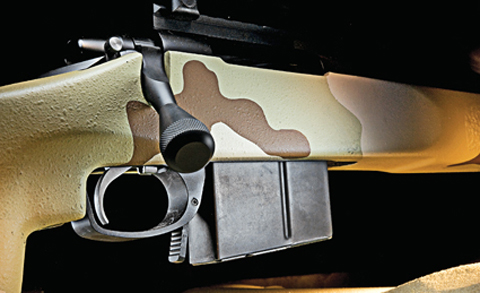
The Templar bolt features one-piece solid construction with an M16-style extractor milled and fit into place to enhance extraction and ejection. Upon opening the bolt primary extraction is increased by 35%, which makes for a very smooth bolt cycle.
Cartridge Details
The first production cartridge ever developed from the ground up to be a true match cartridge is now being loaded with Hornady components, with the potential to become the true modern rifleman’s cartridge. Developed to give competitive shooters a factory-loaded cartridge that will allow them to compete and win at the highest levels of shooting, the 6.5 Creedmoor is making its way into the tactical and hunting worlds. Chambered by several manufacturers of rifles, the 6.5 Creedmoor is making its debut as a hunting or tactical round in Hornady’s new “Superformance” line of ammunition. Loaded with both 120- and 140-grain GMX bullets, the 6.5 Creedmoor brings a level of precision to long distance rifle shooting that is currently unmatched. In addition, its light recoil makes it very easy to shoot for extended periods and is perfect for any North American game, up to and including elk. Of course, it could also be an excellent choice for law enforcement or military operations requiring both short and long distance shots.

The Templar bolt features one-piece solid construction with an M16-style extractor milled and fit into place to enhance extraction and ejection. Upon opening the bolt primary extraction is increased by 35%, which makes for a very smooth bolt cycle.
“Moon” built my test rifle himself using a receiver from G.A. Precision called the short action “Templar,” which accepts Accuracy International AW double-stack magazines. These magazines have plenty of interior space, an asset that reloaders will appreciate. The Templar bolt is one-piece solid construction with an M16-style extractor milled and fit into place to enhance extraction and ejection. Primary extraction is increased by 35% — which means that upon opening the bolt, the case is pulled out of the chamber 35% more upon opening, making for a very smooth bolt cycle. This modification is in both the receiver and bolt. The receiver body is hardened 416 stainless steel and is radiused so it still fits a Model 700-style stock. The recoil lug is precision-ground and double pinned, while the bolt stop has been changed to the G.A.P. Style side release. The bolt/handle is now one piece, machined from a solid piece of 4320 CM and heat-treated. The knob itself is the only part that is threaded. The handle is slanted to the rear and not straight for ease of operation and is nicely checkered for a solid grip while cycling the action.
The stock used for the test gun is a Manners Composite model # T5A with thumbhole, which was given a desert camouflage design by Todd Jackson at Manners. The stock features a KMW cheekpiece insert so the shooter can set their cheekweld as desired. The T5A version is designed as a right hand grip with a small thumb rest on the left side of the stock. Although the T5A version is a right hand stock, it was designed so a left hand grip could also be obtained. A lot of time went into the design of the grip on this stock, as it moves the shooting hand down and forward so the trigger finger is in a more natural position and not having to over-reach for the trigger face. The area behind the trigger looks odd but it is designed to make the hand return to the same spot each time the stock is gripped. It works well with all sizes of hands and comes with a fixed 1-inch Pachmayr Decelerator recoil pad, however, it can also be ordered with the optional butt spacer system with a half-inch Decelerator pad. The standard weight for the T5A is four pounds.

The barrel used was a Bartlein, 26-inch stainless steel unit with a #14 contour, a 1-in-8.5-inch twist and full fluting. It was coated in black CeraKote, as were all of the exposed metal parts used. The bore diameter is .256 with a groove depth of .264. The stock is pillar bedded with aluminum and set with marine-tex epoxy. The barrel is floating approximately 0.19 of an inch and has a 1.5-inch barrel pad. The forward end of the stock has a dual Picatinny rail attached for optional accessories. The triggerguard/magazine housing is the model M5 from Badger Ordnance. A heavy-duty guard that allows quick loading/unloading via a 10-round, double stack magazine utilizes a time-proven paddle-style magazine release. The guard includes grade 5 torx screws and pre-made bedding pillars to guarantee exact fit and perfect function. Made from aircraft-grade aluminum and hard coat anodized black, the guard with an empty 5-round magazine weighs 10.2 ounces.
While no precision rifleman can always count on being able to use a bipod, having one on such a rifle is essential. G.A. supplied this rifle with an Atlas precision bipod Model BT10, which has 15 degrees of pre-loaded pan and cant with four leg positions and an elevation radius of 5 to 9 inches. Standard two-screw clamp-on style is standard and the unit is made from T6061 Aluminum. Hard anodized black stainless steel springs and fasteners are also used. Non-orientated leg positioning allows either hand to move legs into any of the four leg positions: stowed back, 90 degrees straight down, 45 degrees forward and stowed forward. All leg positions are solid, allowing the shooter to load the bipod at the 45- and 90-degree positions, and the durable rubber feet are suitable for many surfaces.
G.A. uses Badger Ordnance scope rings, which are machined from steel bar stock as serialized matched pairs. This assures both rings are identical and eliminates the damaging effects of mismatched, mass-produced rings.
Maximized rings are designed to fit Picatinny optical rails and are finished with mil-spec black oxide. All the hardware on their rings is designed to exact specifications, including the torx screws that hold the scope securely in the rings.
The threaded SureFire suppressor adapter was added to the barrel and also functions as a high-performance muzzle brake when the suppressor is removed. The patented design greatly diffuses side blast, fights against up/right muzzle movement to help stay on target and eliminates felt concussion back at shooter. Made with heat-treated stainless steel construction, the SureFire adapter provides rock-solid suppressor attachment in seconds without tools.

The Leupold Mark 4 4.5-14×50mm scope offers high resolution and maximum light gathering capability with parallax adjustment and ¼” clicks for windage and elevation.
A precision rifle without a scope is like an airplane without wings. For the precision bolt gun to be its best, it needs a quality optic to search, identify and zero in on targets. It is not unusual to spend just as much, if not more, on the optic as the rifle. In the case of this gun, I used a Leupold Mark IV 4.5-14×50mm ER/T scope. Like all things Leupold, the scope is solidly built with everything one would want in a tactical-grade optic. The Mark IV 4.5-14 has a number of worthwhile features, including the Leupold Index Matched Lens System, which delivers superior resolution from edge to edge of the optic’s visual field, even at 14 power, along with peak image brightness and optimal contrast. In addition, a side-focus parallax adjustment is standard for fast, easy parallax focusing from 50 yards to infinity. M1 windage and elevation adjustment dials with audible, tactile ¼-MOA clicks make adjustment easier under any lighting conditions. The reticle is magnified along with the image, so the shooter can estimate range at any magnification. Available in a durable, subdued matte black finish, the Mark IV 4.5-14 is absolutely waterproof.

The stock features a fully adjustable KMW cheekpiece insert so that shooters can set their cheekweld as desired.
By Dave Spaulding, Images by Sean Utley
BLOG ARCHIVES

2012年04月17日
Viridian Compact Tactical Light
私たちのブログを訪問していただきありがとうございます。あなたがお持ちの場合DIYの要求は私達に電子メールを送信してください。

The new CTL (for C5 Series TacLight) is designed to tuck neatly between trigger guard and muzzle of any railed handgun, including subcompacts, with no overhang. Now even tiny concealed-carry pistols can carry massive illuminating power: 100 lumens of brilliant white light and 140 lumens of eye-dazzling strobe, packed into a sleek, miniature body that fits virtually anywhere.
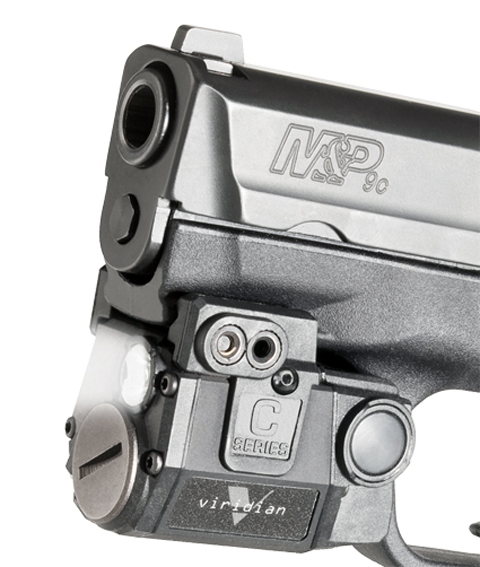
Along with compact size, the new CTL is as tough and versatile as any Viridian C5 Series product, with the same aircraft grade hard-anodized aluminum construction, multi-programmable light and strobe, floodlight type close-quarter combat lens, and exclusive ECR (Enhanced Combat Readiness) function that works with TacLoc holsters to ignite the high-output LED at the instant of draw.
From tactical-life
BLOG ARCHIVES


The new CTL (for C5 Series TacLight) is designed to tuck neatly between trigger guard and muzzle of any railed handgun, including subcompacts, with no overhang. Now even tiny concealed-carry pistols can carry massive illuminating power: 100 lumens of brilliant white light and 140 lumens of eye-dazzling strobe, packed into a sleek, miniature body that fits virtually anywhere.

Along with compact size, the new CTL is as tough and versatile as any Viridian C5 Series product, with the same aircraft grade hard-anodized aluminum construction, multi-programmable light and strobe, floodlight type close-quarter combat lens, and exclusive ECR (Enhanced Combat Readiness) function that works with TacLoc holsters to ignite the high-output LED at the instant of draw.
From tactical-life
BLOG ARCHIVES

2012年04月17日
Trigger Switch Replacement
私たちのブログを訪問していただきありがとうございます。あなたがお持ちの場合DIYの要求は私達に電子メールを送信してください。
Just a couple of photos when I replaced the ordinary switch assembly with another switch assembly with mosfet.
Closeup

BLOG ARCHIVES

2012年04月17日
Loki Weapons System 300 Blackout
私たちのブログを訪問していただきありがとうございます。あなたがお持ちの場合DIYの要求は私達に電子メールを送信してください。
Powerful patrol rifle designed for LE operations!

Loki Weapon System’s Patrol Rifle in 300 Blackout pulls double duty as a suppressor-ready entry weapon that can deliver barrier-penetrating 220-grain subsonic loads, or a quick magazine change can ready flat-shooting 2,300 fps 110-grain loads. Shown with the Vortex 1-4x illuminated scope.
So many AR platform manufacturers—and there were more than 75 at my last count—don’t deviate much from the norm of producing a 5.56mm NATO carbine. One of the benefits of the smaller semi-custom AR builders is their flexibility to anticipate the wants and needs of LE, special operations, military and the general shooting public. Loki Weapon Systems, from Atoka, Oklahoma, is one of the first to bring a new 300 Blackout AR to the market.

Jay Lanston photo
A while back, I conversed with Loki’s CEO, Erik Davis, about reviewing the LWSF M4 Patrol Rifle. Our conversation shortly turned to caliber selection, and I had just learned that Remington and Advanced Armament Corportation had designed a new open-source cartridge dubbed the 300 Blackout (BLK). Needless to say, this choice was available for my test rifle.

This Loki Weapon Systems rifle’s billet lower receiver has CQB grips machinedinto the front of the magazine well.
When the Loki Patrol Rifle arrived, I was immediately pleased with its looks. Made from a billet of 7075-T6 aluminum, the receiver’s milling and finishing definitely possess a certain “cool factor.” Differing from a milspec AR lower, Loki’s features an integrated, oversized triggerguard and what they call a CQB magwell grip. Complementing the lower receiver is a seven-position adjustable Ergo F93 Pro stock and an Egro grip.

A green LaserLyte K-15, easily hooked onto the 12-inch Picatinny rail provided an excellent low-light alternative to the Vortex optic.
By Jay Langston, Images by Oleg Volk
BLOG ARCHIVES

2012年04月16日
Kimber M8400 Advanced Tactical Rifle .308
私たちのブログを訪問していただきありがとうございます。あなたがお持ちの場合DIYの要求は私達に電子メールを送信してください。
Enhanced features and capable of sub-MOA performance!

Given the commitment that Kimber has made to provide law enforcement and civilian shooters with top-grade 1911 pistols for duty and defense, it was no surprise when Kimber announced it was entering the tactical rifle market in January 2007. The Yonkers gunmaker currently catalogs three rifles of this type: the M84 LPT (Light Police Tactical), made on the company’s Model 84 action, the Tactical and Advanced Tactical guns, both based on the larger Model 8400 action. All differ in weight, barrel length and stock options.
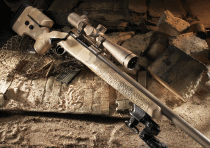
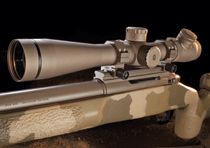
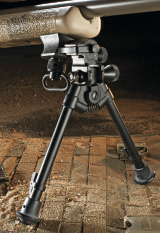

By Stanton Wormely, Jr., Images by Steve Woods
BLOG ARCHIVES

2012年04月16日
Fortis Rail Attachment Point (RAP)
私たちのブログを訪問していただきありがとうございます。あなたがお持ちの場合DIYの要求は私達に電子メールを送信してください。
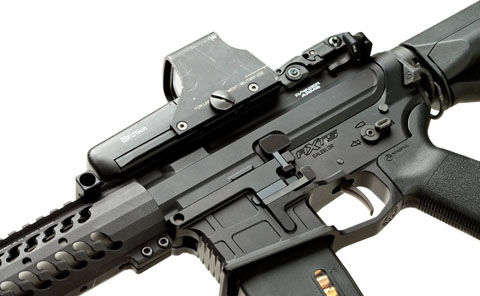
Sling mounts are a funny thing, some people like love QD sockets, some hate them. Other people feel you can only trust a sling that weaves through a mount, others hate the restriction of not being able to pop the sling off. I make no attempt to sway people one way or the other, but a new company named Fortis is taking a familiar spin and going ultra light weight.



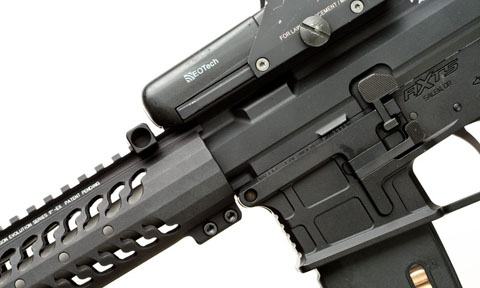
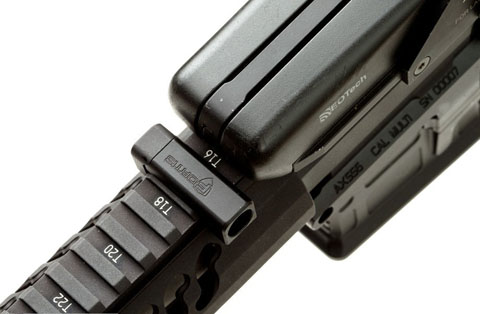
The Fortis Rail Attachment Point (RAP) is a hard coat anodized 6061 aluminum mount which affixes to a standard 1913 rail by way of an allen head screw. The entire mount, including the screw and back plate, weighs in at .35 ounces, which makes it the lightest weight QD rail mount I’ve ever come across. We got ahold of several of these, and had no problems mounting them to rails. The machining is well done, and all edges are rounded. The QD socket itself is anti-rotational, and to test how well the mount held up we locked it to a rail, then stood on the weapon while jerking on the sling. I’ve seen other QD sockets pop when this is done, but there were no such issues with any of these. The Fortis RAP takes up very little rail space, and can mount facing up on down, or side, top, or even bottom rails if you are so inclined.
By Stickman
BLOG ARCHIVES

2012年04月16日
PWS MK114 5.56mm
私たちのブログを訪問していただきありがとうございます。あなたがお持ちの場合DIYの要求は私達に電子メールを送信してください。
Primary Weapons Systems’ first complete piston-driven carbine!

The PWS MK114 is a solid, combat-ready rifle with all the components necessary for work or on the range. Best of all, this purpose-built rifle is priced where an operator can afford it.
Primary Weapons Systems has been building some of the best piston-driven AR uppers for a few years now. They also make muzzle brakes and flash hiders for many of the big name brands. Their accessories are some of the most well thought out devices being made. Most are geared to make any system better, not just look cool. They have come to be respected by many who take these weapons to war or work. Their systems have been proven reliable and are of high quality. To top it off they have always been priced fairly and the company has some of the best customer service in the business. Having met pretty much everyone involved in this company they are all good, hard-working people who just plain love guns.
Many other companies make and have made fine piston-driven guns, but they can be close to two grand just for an upper. That may be what a good chunk of the market may bear, but it is just too much for most in the law enforcement or contracting world. For years anything that even approached a grand was pretty much the ceiling for most cops. Troops certainly don’t make any more real money and contrary to popular belief not every contractor out there is a rich former secret squirrel. The vast majority of those working in the executive protection field, whether here or abroad are hard-working folks who need to save where they can when buying their weapons just like any weapons carrying professional.
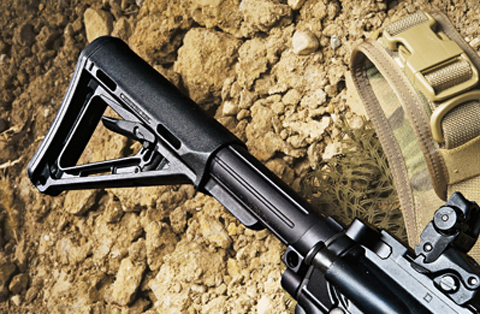
The MK114 includes the PWS buffer tube—a fantastic addition to any AR rifle, but particularly well suited for piston-driven systems.
With the dive the AR market has taken in the last year or so, complete rifle prices for piston-driven guns are generally in the $2,000 to $2,500 range with uppers ranging from about a grand all the way up to two grand. Either way it is a ton of money extra to justify the piston system given that a good gas impingement system will do just fine for most everyone out there. What was really needed was a complete gun with all the attention to detail that PWS provides at a reasonable price. It looks like PWS has come through with just what the doctor ordered.

The upper receiver rail matches nicely to the forend, allowing for the use of SOPMOD-compatible equipment.
When PWS said they were sending me their first ground-up complete gun, it really piqued my interest. Too my surprise not only was the first gun sent my direction, but gun serial number one. Now that takes some confidence for sure. This gun is truly a PWS gun with pretty much everything but the stock, grip, charging handle and barrel being made in house. It is definitely a rifle designed with the operator in mind. It is all about simplicity, easy of care, and ease of operation. It starts with their proprietary handguard that allows each rail to be replaced as needed without removing the barrel nut. It also includes cups for quick-detach swivels on both sides and the bottom. TangoDown SCAR rail covers are provided for the rails. The bolt group is their own design including the carrier and bolt and both are “Micro-slicked” for operational reliability. The barrel is hard-chromed and button- rifled with a 1-in-8-inch twist.
The lower receiver includes their enhanced buffer tube and internals. This tube has proven to be an excellent upgrade on my existing lowers. It is made from one-piece of CNC machined aluminum and eliminates the castle nut and aligns the buffer to the carrier. There is an ambidextrous quick detach as part of the tube. It also has a support for the bolt carrier that helps to deal with carrier tilt on some piston-driven systems. It is indexed, fluted, and very nicely made. The trigger is a nice Mil-Spec single-stage and the lower is very nicely melded to the upper. It is topped with the Magpul MBUS sights. Their newest version, these do not have that annoying gap between the base and the post. They look like pretty much any flip up sight from behind the rifle. Having tested a few rifles with these sights they are more than adequate for most, but any rail type sight could be added to suit the user. If you really feel the need for metal sights they will work just fine.
The stock is a Magpul MOE and is well suited to any real duty use. The barrel on this gun is a 14.5 inches with a permanently attached SM556 flash hider. This was a bit disconcerting to me at first, as suppressors are usually on my guns. But, this particular flash hider will accommodate the KMC QDSS-NT4 and Gemtech HALO suppressors. Honestly though, those of us that use suppressors comprise a very small percentage of overall rifle users, so for most it is just a fantastic flash hider. What it gives you is a true 16.1-inch platform that can accept two of the most popular suppressors out there without modification. It comes with one Magpul 30-round PMag and that ever so important locking device. Here is the best part — the list price on this rifle is $1,549.95. Considering that several companies sell uppers for more than that, it is a great price for what looks to be a great rifle.

The lower receiver mates nicely to the upper and includes a solid standard trigger, or the trigger of your choice can be added at your request.
In order to facilitate accuracy testing a U.S. Optics SN6 scope was attached. This is a 1.5-6 power scope that has seen action on a number of my rifles. It has proven to be incredibly solid and incredibly precise. It is really perfect for a weapon like this as it is smaller, yet powerful enough to get far beyond the range of the caliber. It normally sits on my DMR-10 and has been used on a couple of hunts and with great success as a precision riflescope. It was mounted in a GG&G mount and zeroed.
There is a platform at the range that is used for multiple rifle position shooting. It sits at about 4 feet high and is very solid. My drag bag was coiled up and used as a rest providing for a very solid platform, yet one that may be found in the field. In order to provide a broader spectrum three different rounds of different bullet weights were tested. The good old 55-grain M193 as that is used most often in the law enforcment world, as well as the 62-grain Federal Tactical. That is the round chosen after extensive testing by the FBI and many departments use it to this day. The last was the 69-grain Gold Medal Match. Still used by some, but mostly it provides a good indication of heavier bullet accuracy in the rifle.
Well, the grouping deities were with me that day as the grouping was pretty impressive for this type of gun. Granted, the gun is clearly incredibly accurate, but so much goes into group shooting even a good rifle can look bad when the shooter has a bad day. The largest group produced was the 62-grain tactical. This round has never been known for its accuracy, but today it measured a whopping 0.75 of an inch. It really liked the 55-grain as well, but to my surprise it shot the 69-grain equally as well. It put everything into a 0.75 of an inch group or less, and that is pretty impressive for a gun in that price range.
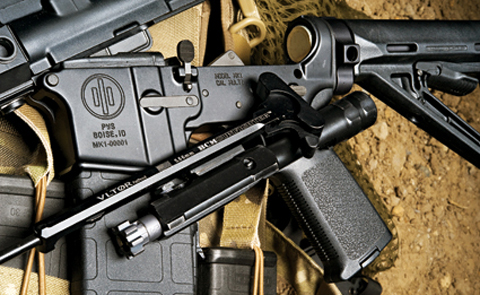
Primary Weapons Systems now uses their own custom-built bolt and carrier, designed specifically for use in piston-driven systems.
The rest of the testing was spent on the range moving, then in and around the shoot house. Not a single malfunction, as expected. What you really notice after awhile is the weight of only 6.9 pounds. That is kind of on the rare side for piston guns and is actually lighter than some gas guns. It really is a testament to the effort PWS made to keep this thing light. Having cut my teeth on an AR during two weeks at Thunder Ranch this rifle would have been a gift from heaven. You can hold this thing in the pocket all day long and given the next to non-existent recoil it is just a joy to shoot. Many of the other piston guns in this price range are downright heavy so this was a pleasant surprise. Given the lack of weight it swings from target to target really fast and the piston system gives it fast shot to shot times. Right out of the box this rifle would work well either on duty, or on the competition range.
By Dave Bahde, Images by Sean Utley
BLOG ARCHIVES

2012年04月16日
Troy M7A1 SBR Upgrade
私たちのブログを訪問していただきありがとうございます。あなたがお持ちの場合DIYの要求は私達に電子メールを送信してください。
Transforming your standard M4 into a covert entry CQB performance machine!
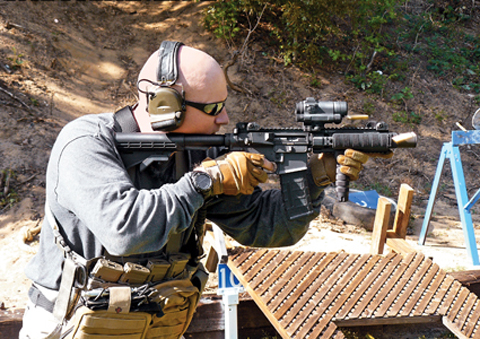
The author squeezes off a long burst on full-auto—notice the pronounced lack of muzzle climb, as the expended cases are still suspended in mid-air. The weapon was found to be extremely controllable and reliable in all rates of fire.
That thing runs like a sewing machine!” As my friend stood next to me, mouth slightly agape, in awe of what he had just witnessed. The final day of testing had just concluded, and we were both standing in the settling dust and drifting gunsmoke, looking almost incredulously at the diminutive rifle slung across my kit. Over the past two days, the 7-inch Troy M7A1 upper receiver had fired over 1,500 rounds of mixed 5.56mm ammunition without so much as a hiccup, and had grouped one exceptionally tight, cold-bore string at 100 yards, measuring in at only 1-MOA.
Meet the M7A1 Personal Defense Upgrade Kit; a blend of form and function recently introduced by Troy Industries. No stranger to the tactical community, Troy is a manufacturer and purveyor of high-quality upper receivers, rail systems, and weapons accessories. Perhaps best known for its BUIS sights, which have become an industry-wide standard item, these precision-machined parts are now OEM equipment on many fine tactical rifle offerings from several major firearms manufacturers (including Ruger and Smith & Wesson). Troy’s excellent MRF and TRX handguards are also very well respected and also come standard on several models of the S&W M&P 15T Rifle, as well as the new Ruger SR-556 gas piston rifle.

According to Steve, the M7A1’s excellent performance is the direct result of a synergy created by mating some of the finest components available. Starting with a 7.5-inch, 1-in-7-inch twist, stainless steel barrel chambered in 5.56mm NATO, Troy then adds either a Noveske KX-3 flash suppressor or a Troy Claymore muzzle brake, both of which give the gas system and muzzle velocity an added boost, comparable to a barrel nearly 2.5 inches longer than the one to which either is affixed. The barrel assembly is then mounted to a Mil-Spec upper receiver and enshrouded by Troy’s free-floated MRF or TRX Battle Rail handguards. The completed receiver is then charged with a MP inspected Mil-Spec bolt, bolt carrier and charging handle. The completed receiver is topped with Troy’s M4 pattern front and rear folding BUIS sights, and Troy’s Modular Battle Grip is added for additional controllability. All of these components are shipped encased in a Hardigg Storm Case, replete with pre-cut closed-cell foam inserts. As an added touch, Troy also includes an Orvis cleaning kit adorned with the Troy logo, and a Troy single-point sling.
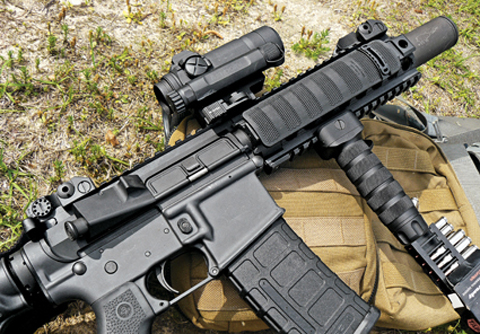
The Troy M7A1 PDW upper is supplied as an upgrade kit (less lower receiver) and is not yet offered as a complete rifle. Here, the upper receiver is shown with the Troy MRF rail system and Noveske KX-3 (as tested), and is also available with the new TRX rail and Claymore muzzle brake (also of Troy manufacture). The SBR was outfitted with the exceptional Aimpoint Comp M4s (not included), as well as Troy’s Modular Battle Grip.
By P. J. White
BLOG ARCHIVES

2012年04月15日
Norwegian Kommandos
私たちのブログを訪問していただきありがとうございます。あなたがお持ちの場合DIYの要求は私達に電子メールを送信してください。
Special operations units with tenacity rivaling that of their Viking ancestors!

This Kommando secures an LZ with his C8 carbine, featuring an Aimpont optical sight.
During the Cold War, Norway was the northern flank of NATO, vulnerable to an invasion by the Soviet Union. If the Soviets came south, Norwegian troops, especially the special forces troops, would have attempted to delay the advance until NATO reinforcements in the persons of British Royal Marine Commandos, Dutch Marines, and U.S. Marines arrived. With the end of the Cold War, Norwegian special ops troops retained varied missions including countering terrorism. Currently, Norwegian special operations capability rests with four units.

Norwegian Kommandos come ashore ready for action, sporting HK G36 rifles and an AG36 grenade launcher in winter camo paint.
The Haerens Jegerkommando, generally known as the HJK, in one form or another has been in existence since 1962. In addition to having certain troops assigned to units within the HJK, it also serves as the Army Special Forces Command and the training cadre for other Norwegian special ops units. Based at Elverumn in southeast Norway, HJK has a headquarters unit, a parachute unit — which is assigned both airborne missions and training duties for all of the Norwegian armed forces — and a Spesialjegere (commando) unit. Within the parachute unit is a pathfinder platoon which functions as a reconnaissance unit and also trains other recon troops.

Deployed to protect the frigid fjords that make up Norway’s coastline, a Norwegian Coastal Ranger takes aim with his HK G36 as his boat speeds towards the shore.
Closely related to the HJK are the Forsvarets Spesialkommando (FSK), to the extent that Norwegian special forces are often referred to as FSK/HJK. However, FSK has a distinct counter-terrorist mission to protect Norway’s offshore oil platforms, counter hijackings, and carry out hostage rescue operations. FSK has worked closely with U.S. Delta Force and the British SAS, including missions in Afghanistan. On certain barricade or hostage incidents, the Norwegian police will call in FSK.
By Leroy Thompson, Images by Forsvaret Photos
BLOG ARCHIVES

2012年04月15日
Rockriver Arms PDS 5.56mm
私たちのブログを訪問していただきありがとうございます。あなたがお持ちの場合DIYの要求は私達に電子メールを送信してください。
Piston-Driven Systems in pistol and carbine form taking the battlefields by storm!

Rock River Arms has developed a carbine and pistol chambered for 5.56mm using their proprietary Piston-Driven System (PDS). Several items make the PDS unique, such as the matte black, hard polymer handguards and the full-length Mil-Std-1913 rail running from where the gas block traditionally would be back to the rear of the upper receiver. It is underneath this rail that the operating system is housed.
Gas piston versus direct gas-impingement is a topic currently dominating the AR world. Some are embracing the new piston guns while others view it as an answer to an unasked question. Whichever side you take, the fact remains that there are high-quality rifles in both camps.
The majority of AR platform manufacturers have taken the “op rod/piston” route replacing the gas tube assembly and carrier key on the bolt carrier. These carbine-sized guns on the outside are virtually identical to their gas-impingement counterparts. The lower receivers are unmodified with the same buffer tube assembly being used.
When Rock River Arms (RRA) decided to throw their hat in the gas piston ring they didn’t want to simply copy something that was already out there. They wanted their piston system to be unique. I believe they have accomplished that mission.

The absence of the traditional operating system means that no buffer assembly is required, allowing the addition of a side-folding stock on the carbine.
Two new firearms chambered for 5.56mm have been released with RRA’s Piston-Driven System (PDS) — a carbine and pistol. Several items make the PDS unique; the first thing that most shooters will notice are the handguards. These matte black, hard polymer grips are specially designed to mate with the new operating system.
The next item of note is the full-length Mil-Std-1913 Picatinny rail running from where the gas block traditionally would be back to the rear of the upper receiver. It is underneath this rail that the operating system is housed.
To work the bolt you will use an ambidextrous charging handle located out in front, above the forward portion of the handguard. The charging handle folds against the side of the gun when not in use and is “non-reciprocating.” It is not affixed to the operating rod so it does not run back and forth when the gun cycles. Out front on the right side of the gun is a two-stage, adjustable gas regulator. You can adjust it with the tip of a round and a coin or flat-head screwdriver.
Inside the rail you’ll find the operating rod and recoil spring. The bolt and bolt carrier are not interchangeable with a standard AR. The absence of the tradition operating system means that no buffer assembly is required. For the PDS pistol this mean a clean, pistol-like profile without that odd looking, naked buffer tube sticking out the back. On the carbine this allows the addition of a side-folding stock.

The PDS Carbine’s two-position adjustable regulator is found on the right side of the regulator housing and features a Picatinny rail for attaching any number of accessories.
Of course there are many similarities to the modern AR rifle. The lower receiver accepts all M16/AR-15 magazines. The controls: manual safety lever, bolt catch, magazine release button and trigger are all stock AR. Speaking of triggers, RRA has installed their excellent two-stage trigger, one of the finest factory versions you can get.
The retractable stock on the carbine model is a normal M4 variety. For pistol grips, RRA has installed the comfortable Hogue finger groove model. Out front at the business end you’ll find the familiar A2 flash suppressor. Both the pistol and carbine have takedown and pivot pins identical to your standard AR, connecting the upper and lower receivers.
Carbine Details

The PDS Carbine’s matte black, hard polymer handguards are specially designed to mate with the new operating system and ribbed for a comfortable grip.
Let’s take a second to address the specifics of the carbine version. First of all RRA has installed a 16-inch chrome moly barrel with a 1-in-9-inch twist. The overall length of the gun with the stock folded is only 26 inches. with the stock extended it is 37.5 inches.
By Paul Markel, Images by Steve Woods
BLOG ARCHIVES

2012年04月15日
Halo Arms Maximus .50 BMG
私たちのブログを訪問していただきありがとうございます。あなたがお持ちの場合DIYの要求は私達に電子メールを送信してください。
Ultimate hybrid system, competition accuracy with military ruggedness, bringing down hardened targets!

A .50 BMG rifle is an essential law enforcement tool, and the Halo Maximus has some unique features that set it apart from most other .50 BMG rifles. The Maximus is manufactured almost entirely of aluminum alloy and steel, which comprises the barrel, receiver, bolt, fire control components and a few other elements.
When police special tactical units are evaluated by the Department of Homeland Security, the presence or absence of a .50 BMG (Browning Machine Gun) caliber precision rifle is a critical rating factor. While a .50 BMG caliber rifle may seem to be overkill in an urban or even rural environment, there are scenarios in both environments when nothing else will do. Subjects barricaded behind barriers that are impervious to smaller caliber firearms can be defeated with a .50 caliber rifle. For instance, situations where terrorists have taken over the cockpit of an airliner can be alleviated only by using a .50 caliber rifle, since the windscreens of commercial jet aircraft are designed to resist impacts much like those of smaller caliber rifle bullets. In facilities where bullet-resistant glass is present, such as banks, only a .50 BMG caliber rifle can eliminate threats.
Thus, while some might consider a .50 BMG rifle unnecessary in law enforcement, the opposite is true. A .50 BMG rifle is an essential law enforcement tool. Although situations calling for a .50 BMG caliber rifle are relatively rare, when a situation occurs where a .50 BMG caliber rifle is necessary, it is too late to have a SWAT team precision tactical marksman qualified in the use of the big rifle. Unlike the famous LA Shootout where officers borrowed semi-automatic small caliber rifles from sporting goods stores, .50 BMG rifles aren’t very common, even in gun stores. In addition, if a situation arises where a .50 BMG rifle is to be employed, the responsible team member must be thoroughly qualified to use it and must maintain his proficiency so that when the worst happens, the team .50 BMG rifle can be employed without fear of legal repercussions due to training or proficiency issues.

The Halo Maximus uses a BAT Machine receiver and locks via two massive lugs at the front, spaced opposite from each other. The bolt handle can be considered as safety lug, and the Maximus’ bolt operation was butter-smooth right from the box.
Because a firearm without ammunition is no more than a very expensive club, this is another factor in the use of a .50 BMG rifle since ammunition of various types has decidedly different characteristics. All .50 BMG ammunition is capable of defeating targets that would withstand even the most potent bullets of smaller calibers, but the team leader must choose his ammunition with just as much care as he did the team rifle. Commonly available .50 BMG ammunition includes M2 and M33 ball, M2 armor-piercing (AP), M8 armor-piercing incendiary (API), armor-piercing match from Anthena and plain commercial match ammunition. Mark 211 API is also available to law enforcement, but this most potent API has behind target incendiary effects that probably aren’t desirable for law enforcement purposes.
Of commercially available US military ammo, M8 API is generally considered to be the most accurate, although if used operationally, the incendiary effect must be taken into consideration. The Army has begun purchasing a match-grade round for its M107 rifles. This round is currently designated the XM1022 and is made by Lake City Army Ammunition Plant. The design is similar of the Anthena armor piercing ammunition tested herein, but without the armor-piercing penetrator. I recommend match-grade ammunition that will defeat hard targets. For tough targets, Anthena AP match ammunition imported by Drake Associates probably represents the best balance of accuracy and terminal effects, although it is expensive. I have fired Anthena AP Match bullets against inch-thick armor steel at 300 meters distance and not only did every round penetrate with enough behind armor effect to be lethal, the three-round groups we fired could be covered with the palm of our hand. In one group, two rounds were actually touching. The Anthena AP has been ordered in large quantities (over 5,000 rounds) by a major U.S. police department for harbor protection and is in use by several federal law enforcement agencies.

The Halo Maximus’ weight is one factor that contributes to the lack of felt recoil, but more important is the rifle’s aggressive muzzle brake, which counters recoil by essentially pulling the rifle forward as the bullet leaves the muzzle.
When it comes to rifles suitable for law enforcement use against hard targets, the selection is limited. One of these is the Halo Arms Maximus, which is a large rifle—but when dealing with a cartridge that launches a half-inch diameter bullet weighing as much as 750 grains at nearly 3,000 feet per second (fps), the rifle that shoots it is also going to be big—and heavy. The Maximus is nearly 5 feet in length with a standard 30-inch chrome molybdenum steel barrel. A carbine version with 22-inch barrel is also available.
By Charlie Cutshaw, Images by Doug Richardson
BLOG ARCHIVES

2012年04月14日
Century Arms GOLANI 5.56mm
私たちのブログを訪問していただきありがとうございます。あなたがお持ちの場合DIYの要求は私達に電子メールを送信してください。
Full-sized battle rifle that goes beyond the typical AR mold!

As per usual, I knocked out my chronographing chores first. Next I would bench the rifle and fire a few shot groups for record. The Golani is not a bench rifle, it’s a fighting gun and as such the majority of my range testing would take the form of shoot and move drills and training. The red dot Vortex optic provided a clear reference point for rapid target engagement. This was particularly apparent during moving drills.
Thanks to the upswing in sales over the last couple of years, the majority of American gun owners equate the .223 cartridge with the myriad Stoner-based rifles now available. Nonetheless, the AR is not the only .223 game in town. A number of manufacturers are building self-loading rifles chambering the .223 and 5.56mm NATO cartridge.
No, the .223 and 5.56×45mm are not identical. The rule is that .223 will work in 5.56mm guns but not vice versa. Think of it like .38 Special and .357 Mag. The 5.56×45mm is akin to a magnum version of the .223.
Chambered in the 5.56mm, the gas-operated Golani battle rifle has an 18-inch barrel with a 1-in-9-inch twist. A “birdcage” muzzle brake/compensator is found on the business end. Like the original Galil rifle, the Century model has a skeletonized folding stock and distinctive polymer forend and pistol grip.
The finish on the rifle is completely in black (parkerized) and each gun comes with two, 35-round magazines and one 5-round “sporting” magazine. Empty weight is 8.13 pounds. Overall length is just a bit more than 38 inches. With the stock folded the rifle’s storage length is 29 inches.

Century Arms Golani Sporter, a faithful recreation of the famous 5.56mm Israeli Galil rifle, featuring a skeletonized folding stock and distinctive pistol grip.
Sling mounts are found on the left side. The manual safety lever is ambidextrous. On the right side of the frame it operates like a standard AK. On the left side the safety is a lever—forward for safe, back to fire. This particular version of the rifle does not include a bayonet lug, as older models did.

The charging handle on the left side, attached to the bolt and reciprocates with it. Note that the manual safety and mag release is ambidextrous.
The magazine release catch operates again like an AK, but has a guard to prevent accidental engagement if that should be a concern. This guard, however, prevents rapid one-hand reloading where the shooter uses a fresh magazine to unseat the empty one. AK operators know this technique well. To install a magazine, first hook the forward lip of the magazine and rock it back in place like the AK. As it is found in the center, the magazine release is ambidextrous.
The charging handle is attached to the bolt and reciprocates with it. Rather than protruding out of the right side, the handle points upward and can be operated with the with the supporting hand reaching over the top of the receiver.

The Vortex “StrikeFire” red dot optic provided quick reference for rapid target engagement.
Sights
The sights on the Golani Sporter mimic those of the original Galil rifle with one major exception. The military rifles had tritium night-sights on the front and rear. Due to import restrictions, these “radioactive” sights are left off of the current model. As far as the standard iron sights are concerned, they are fully adjustable. The rear sight is a peep with dual apertures. The front sight post is protected by a circular steel guard.
The front sight on the Golani adjusts for both windage and elevation like the Kalashnikov. Windage adjustments can be made with a large flathead screwdriver. You will need a dedicated tool to make elevation adjustments on the front sight post. A mil-spec AK front sight tool will work. TAPCO offers a great front sight tool that allows you to change the elevation on the Galil, AK, or SKS.
Though the iron sights are fully functional, the rear peep aperture is small and the front sight post is difficult to pick up during rapid target engagement. I wanted to mount some type of red dot optic on the rifle, but in its standard configuration that would be impossible. Despite this obstacle, I soon had the solution to the mounting problem.
Midwest Industries has a four-way aluminum rail system designed specially for the Golani. Unfortunately I found out too late about it, but I did install their universal AK handguard on the rifle. Both of these Midwest Industries rails completely replaces the standard plastic forearm.
With the rail secured in place, I decided to mount a new Vortex “StrikeFire” red dot optic on the rifle. A single scope ring mounted easily to the top rail. Underneath, on the bottom rail I installed a vertical foregrip for better control.
Range Needs
In addition to firearms, Century International Arms also sells ammunition. Along with the Golani rifle, I acquired some .223 ammunition from Barnaul, a Russian Manufacturer. The Barnaul loads were a 62-grain JHP with zinc cases and a 55-grain JSP with lacquered steel cases. Also along for the ride were Federal’s American Eagle 55-grain FMJ and Wolf’s “Military Classic” 55-grain FMJ.

Midwest Industries 4-Way rail system for the Golani should fit perfectly on it and allow operators the option to mount various accessories.
As I put pen to paper, Century has spare/extra Golani magazines in stock for more than reasonable prices. I looked online and found steel Galil magazines could be found from $35 up to $75 a piece. TAPCO recently introduced a polymer 30-round magazine for the Galil. I found these online for less than $15 everywhere I looked. In addition to steel and polymer magazines, I would take a LULA tool to the range with me. The LULA tool saves your thumbs and lets you easily load your magazines to capacity. The AK LULA works with AK-47, AK-74, and Galil/Golani magazines.
No battle rifle would be complete without a sling of some sort. For this review I decided to attach a Vickers sling from available from Blue Force Gear. This is a two-point adjustable sling with padding in the shoulder area. The Vicker sling is strong/tough and has the added benefit of being adjustable with one hand. Yes, you can snug it up or loosen it with your support hand only.

Running the Golani through numerous training drills, the gun performed like a true, proven battle rifle. The Vortex “StrikeFire” red dot optic provided quick reference for rapid target engagement.
During three separate outings with the Golani, I consumed somewhere in the neighborhood of five hundred rounds, the majority of which were the Barnaul and Wolf ammunition. Unlike many U.S. made AR’s, the Century rifle had no problem with the zinc and lacquer steel cases. It consumed round after round and cycled the ammunition consistently even when the barrel and chamber were smoking hot.
Final Notes
The Golani Sporter proved a tough, reliable rifle. The gun is most definitely classified as a “rifle” not a “carbine.” The 18-inch barrel and 38-inch length along with the more than eight-pound empty weight give the Golani the feel of a full-sized rifle.
By Paul Markel
BLOG ARCHIVES

2012年04月14日
PTR-32 7.62×39mm
私たちのブログを訪問していただきありがとうございます。あなたがお持ちの場合DIYの要求は私達に電子メールを送信してください。
Prototype NATO carbine gets redesigned for more combat reliability!

Not only is PTR-91, Inc. manufacturing varieties of their HK-91 clone, the company now manufactures a Heckler & Koch-style carbine that never got beyond prototype stage in Germany – the PTR-32, an improved version of the HK32 that was designed in the early 1960s.
One of the primary military rifles of the mid-20th Century was the Heckler & Koch G-3, a German abbreviation for Gewehr (rifle) Model 3. The G-3 was select fire, i.e. capable of full automatic fire, but a semi-automatic version was produced and marketed as the HK-91. Although an excellent rifle, the HK-91 was expensive and relatively few were imported prior to 1989, when Heckler & Koch ceased importation. Although there has been considerable demand for HK to resume production of the HK-91, the HK-91 tooling and technical data package was sold to the Portuguese government. HK officially stated that it could not justify resuming HK-91 production. JLD Enterprises — now officially known as PTR-91, took up the slack, purchased the HK-91 tooling from the Portuguese government and began making HK-91 rifles under the name PTR-91 that are every bit as good as the originals because they are manufactured to strict original German military standards using HK tooling. The PTR-91 was so successful that the company changed its name to PTR-91, Inc.

Strict adherence to original tolerances allow for the PTR-32’s effortless disassembly and reassembly.
Since the original HK-91 rifles and carbines ceased to be manufactured, production engineering has evolved and improved. Today, computer numerical controlled (CNC) machinery ensures that exacting high quality standards can be achieved at relatively low cost. So even though HK tooling is used to manufacture PTR-91 rifles and carbines, these new rifles not only equal the originals, but actually improve on them.

Rails at three, six and nine o’clock on the handguard readily accept any number of accessories.
PTR-32 History
Not only is PTR-91, Inc. manufacturing never before available varieties of their HK-91 clone, the company now manufactures a HK carbine that never got beyond prototype stage in Germany – the PTR-32, an improved version of the HK32 that was designed in the early 1960s. The HK32 history, while brief, is interesting in itself. The success of the G3 caused many foreign governments to inquire as to whether HK could manufacture G3/HK-91 type rifles in calibers other than 7.62×51mm. Perhaps not surprisingly, the alternate caliber most in demand was the Soviet 7.62×39mm. With that in mind, HK engineers set about designing a new rifle, derived from the G3, but chambered in 7.62×39mm.
By Charlie Cutshaw, Images by Doug Richardson
BLOG ARCHIVES

2012年04月14日
R&R Target Saiga Tactical 12GA
私たちのブログを訪問していただきありがとうございます。あなたがお持ちの場合DIYの要求は私達に電子メールを送信してください。
R&R Targets has taken the rugged and reliable Saiga-12 shotgun and redesigned it with more user-friendly controls, making it more shootable and far easier to run.
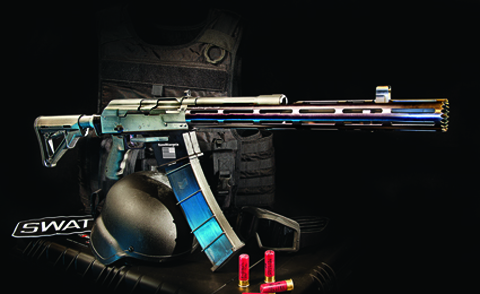
R&R Targets has taken the rugged and reliable Saiga-12 shotgun and redesigned it with more user-friendly controls, making it more shootable and far easier to run.
Removing the R&R Targets Saiga shotgun from its box inside, I felt a little like the Crocodile Dundee movie character who when drawing his bowie knife against some miscreant armed with a switchblade exclaimed, “Now, that’s a knife!” My coworkers cast their shocked glances in my direction and I believe I heard one exclaim, “You got a flamethrower?” Not really but in a manner of speaking, I guess I did.
The Saiga-12 shotgun is a Russian made, 12 gauge, magazine fed, gas/piston operating, semi-auto shotgun. Based on the ubiquitous Kalashnikov design the shotgun is manufactured in Russia at the Izhmash factory. It is a solid piece of weaponry, as you would expect from the designers of the AK. The problem is that as it comes from the factory, the Saiga has some design characteristics that are less than ideal due to importation restrictions placed on the design. It comes with a trigger group placement that is rearward of the standard AK, a standard stock, no choke and a limited sight radius. The appeal of the shotgun is that it is box fed with 10-, 12- and even 20-round drum magazines available. Although the Saiga shotgun has developed quite a following with tactical shotgun shooters the first thing most owners do is seriously modify the shotgun. This involves time with a gunsmith and parts replacement. The end result is that you may get a better designed semi-auto shotgun but still with some design issues, i.e. charging handle and safety on the right side of the receiver that are less than ideal. What if you wanted to incorporate the best of the AK and AR into your Saiga? Could it be done?
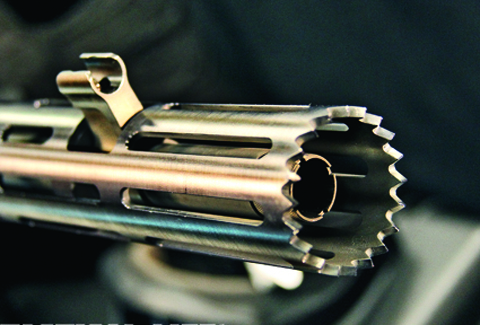
The barrel of R&R Targets shotgun displays the saw teeth at the end of the full-length handguard, allowing the gun to be used in a door-breaching role.
Robert Wright and the fine folks at R&R Targets have done just that. Taking the solid design of the Kalashnikov they modify, refinish and insert new parts to make their Saiga a more solid shooter that does not require a separate manual of arms than the AR with which many of you are intimately familiar.
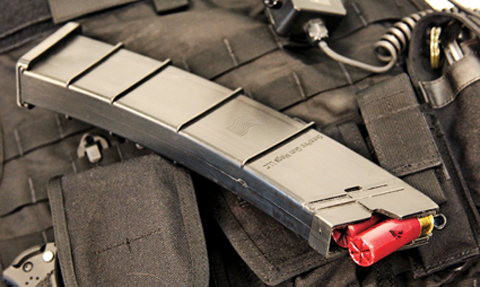
The 12-round mags allow plenty of loads plus a diversity of ammunition to be carried by the operator that are only a mag change away.
R&R Targets supplied one of their Tactical Packages for testing and evaluation. According to Robert Wright no part is left alone. A partial list of the work done includes: Weld fill holes in the receiver and mill slots for new safety, magazine release and stock adapter; ream the forcing cone for more uniform shot patterns and less felt recoil; cut and thread barrel to accept Remington chokes; polish and smooth action; install R&R Targets proprietary aluminum parts including aluminum triggerguard, magazine well, magazine release, safety, grip adapter, and vented handguard; and install new adjustable stock, grip, choke, trigger (with trigger job). R&R then does a ceramic coating of the barrel and frame. The result is an aesthetically pleasing Saiga with an ambidextrous safety, standard AR magazine release, and left side placed charging handle that shoots very well. The R&R rework is a very intimidating design with the full-length vented handguard that incorporates a saw-tooth design on the business end for possible use as a breaching shotgun. From the muzzle end this makes the barrel look enormous and certainly intimidating. The standard Saiga-12 is big and heavy, but the R&R design reduces overall weight by replacing steel with CNC machined aluminum.
By Kevin Davis, Images by Jeff Rose
BLOG ARCHIVES

R&R Targets has taken the rugged and reliable Saiga-12 shotgun and redesigned it with more user-friendly controls, making it more shootable and far easier to run.

R&R Targets has taken the rugged and reliable Saiga-12 shotgun and redesigned it with more user-friendly controls, making it more shootable and far easier to run.
Removing the R&R Targets Saiga shotgun from its box inside, I felt a little like the Crocodile Dundee movie character who when drawing his bowie knife against some miscreant armed with a switchblade exclaimed, “Now, that’s a knife!” My coworkers cast their shocked glances in my direction and I believe I heard one exclaim, “You got a flamethrower?” Not really but in a manner of speaking, I guess I did.
The Saiga-12 shotgun is a Russian made, 12 gauge, magazine fed, gas/piston operating, semi-auto shotgun. Based on the ubiquitous Kalashnikov design the shotgun is manufactured in Russia at the Izhmash factory. It is a solid piece of weaponry, as you would expect from the designers of the AK. The problem is that as it comes from the factory, the Saiga has some design characteristics that are less than ideal due to importation restrictions placed on the design. It comes with a trigger group placement that is rearward of the standard AK, a standard stock, no choke and a limited sight radius. The appeal of the shotgun is that it is box fed with 10-, 12- and even 20-round drum magazines available. Although the Saiga shotgun has developed quite a following with tactical shotgun shooters the first thing most owners do is seriously modify the shotgun. This involves time with a gunsmith and parts replacement. The end result is that you may get a better designed semi-auto shotgun but still with some design issues, i.e. charging handle and safety on the right side of the receiver that are less than ideal. What if you wanted to incorporate the best of the AK and AR into your Saiga? Could it be done?

The barrel of R&R Targets shotgun displays the saw teeth at the end of the full-length handguard, allowing the gun to be used in a door-breaching role.
Robert Wright and the fine folks at R&R Targets have done just that. Taking the solid design of the Kalashnikov they modify, refinish and insert new parts to make their Saiga a more solid shooter that does not require a separate manual of arms than the AR with which many of you are intimately familiar.

The 12-round mags allow plenty of loads plus a diversity of ammunition to be carried by the operator that are only a mag change away.
R&R Targets supplied one of their Tactical Packages for testing and evaluation. According to Robert Wright no part is left alone. A partial list of the work done includes: Weld fill holes in the receiver and mill slots for new safety, magazine release and stock adapter; ream the forcing cone for more uniform shot patterns and less felt recoil; cut and thread barrel to accept Remington chokes; polish and smooth action; install R&R Targets proprietary aluminum parts including aluminum triggerguard, magazine well, magazine release, safety, grip adapter, and vented handguard; and install new adjustable stock, grip, choke, trigger (with trigger job). R&R then does a ceramic coating of the barrel and frame. The result is an aesthetically pleasing Saiga with an ambidextrous safety, standard AR magazine release, and left side placed charging handle that shoots very well. The R&R rework is a very intimidating design with the full-length vented handguard that incorporates a saw-tooth design on the business end for possible use as a breaching shotgun. From the muzzle end this makes the barrel look enormous and certainly intimidating. The standard Saiga-12 is big and heavy, but the R&R design reduces overall weight by replacing steel with CNC machined aluminum.
By Kevin Davis, Images by Jeff Rose
BLOG ARCHIVES

2012年04月13日
Sig Sauer P226 TAC OPS .40
私たちのブログを訪問していただきありがとうございます。あなたがお持ちの場合DIYの要求は私達に電子メールを送信してください。
Delivering high performance in combat-proven firepower!

The Cam-Clamp mounting system for the Xiphos NT takes some of the pain out of adding a weapon light, allowing the user to add it directly to the spot where it is needed, and fasten it securely without tools.
The handgun serves only one purpose, whether riding in a duty belt or concealed by plainclothes officer or civilian—to be there when needed. Because the handgun is the poorest of firearms when it comes to delivering devastating firepower to an assailant, it is incumbent that it works perfectly every time it is produced. Or, as renowned trainer Clint Smith says, “The handgun is there so you can fight your way to a rifle.”
Any number of manufacturers will be glad to tell you their handgun fits the bill, and, in fact, many of them will be correct. However, one name that always rises to the top is Sig Sauer. My first experience with the pistols of Sig Sauer dates back several decades or more, and involved their P220.

Whether you ride in a patrol unit, work plain clothes, kick in doors, or tromp through some dusty foreign land, the Sig Sauer Tac Ops can get the job done for you.
Some time after that, the Texas Department of Public Safety decided to swap their hallmark S&W .357 Mag revolvers for pistols. When the Texas dust settled, Sig Sauer was riding the hips of DPS commissioned officers, where they still remain (chambered for the .357 Mag equivalent .357 Sig today) and my exposure to these fine Swiss-originated pistols increased.

Polymer Magwell two-piece grips with a highly effective pebbling on the side and rear of the panels (along with checkering on the pistol’s front strap) make the Tac Ops secure in the hand when shooting. Checkering on the Tac Ops frontstrap is sharp enough to provide an extra measure of recoil control. Note the vertical serrations on the Plus Two mag basepads.
The Texas DPS personnel are not alone in choosing Sig Sauer, with estimates running as high as over 30 percent of officers choosing them, including a number of Federal agencies. (Even the Navy SEALs are known to have more than a few around.) Aside from the legendary Swiss clockwork smoothness of the Sig Sauer pistols, the one thing most attributed to the pistols is ruggedness. They certainly meet our earlier qualification that the handgun should “work perfectly every time it is produced.”
By D.K. Pridgen
BLOG ARCHIVES

2012年04月13日
U.S. Marsoc Training center
私たちのブログを訪問していただきありがとうございます。あなたがお持ちの場合DIYの要求は私達に電子メールを送信してください。
Top of the line tools and training for Marines keep the tip of the spear extra sharp!

Whether training in the California desert or fighting in the mountains of Afghanistan, the operators of MARSOC are among the best trained and equipped warriors in the fight for freedom.
“In every clime and place” is more than a line in the Marine Corps hymn; it is the mantra of a new breed of warriors. An elite force in itself — because they are Marines, and special because of their missions — the trigger pullers of Marine Special Operations Command (MARSOC) assure the tip of the SOCOM spear is honed and ready.
MARSOC
After September 11, 2001, the National Training Center (NTC), located thirty-plus miles north of Barstow, California, became the training ground for counter-insurgency missions. Subsequently, special operations forces came to practice the deadly art of unconventional warfare, special reconnaissance and direct action missions. MARSOC was activated on February 24, 2006 at Camp Lejeune, North Carolina, where it is headquartered, as the Marine Corps component of the U.S. Special Operation Command (SOCOM). Though it began with a humble start, plans are for the unit to swell to 2,500 Marines, once it is fully operational. After its initial activation, members from both the 1st and 2nd Force Reconnaissance companies transferred to MARSOC, where they formed the 1st and 2nd Marine Special Operations Battalions (MSOB) located at Camp Pendleton, California, and Camp Lejeune, North Carolina respectively.
In addition to the two MSOBs, the other subordinate units based out of Camp Lejeune, North Carolina, include: 3rd Marine Special Operation Battalion (MSB), Marine Special Operation Intelligence Battalion (MIB), Marine Special Operations Support Group (MSOSG) and the Marine Special Operations School (MSOS).

The M4A1 is designed for speed of action and light weight, while the M203 Grenade Launcher provides additional firepower to the operator.
As an active component of SOCOM, these spec op Marines conduct the following special operations force (SOF) missions: Direct Action (DA) — short-duration strikes and other small-scale offensive actions taken to seize, destroy capture, recover or inflict damage in denied areas. Special Reconnaissance (SR) — acquiring information concerning the capabilities, intentions and activities of an enemy. Foreign Internal Defense (FID) — providing training and other assistance to foreign governments and their militaries to enable the foreign government to provide for its country’s national security.
By Fred Pushies
BLOG ARCHIVES

2012年04月13日
Detonics .45 Combat Master
私たちのブログを訪問していただきありがとうございます。あなたがお持ちの場合DIYの要求は私達に電子メールを送信してください。

Another photo review of the Detonics .45 Combat Master, black version, from Tokyo Marui
The box

In the box with the usual black cloth covering the styropor for proper presentation.

Comes with one 18 rounds silver magazine

Left and right side view. I would say the finish looks good but not exceptional.


The sight kind of hard to use without white marks on it.

Thumb safety is not ambidextrous, although it is like the real one, it is a minus factor for me since I am a lefty.

The plastic wooden finish grips looks good, better than the gun's body. Although small it fits nicely into my medium sized hand.

Barrel looks authentic.

I tried to shoot it for about 6 meters and I was surprised at the first shot, it went to high above the traget. But after 5 rounds the groupings got better. the last 4 rounds went into the center a groupings of about 2cm.

BLOG ARCHIVES

Posted by echigoyaworks
at 12:30
2012年04月13日
Bulgarian AK-74 5.45×39mm
私たちのブログを訪問していただきありがとうございます。あなたがお持ちの場合DIYの要求は私達に電子メールを送信してください。
A custom Kalashnikov project turns a pile of parts into a treasured warfighter!

By combining a demilled AK-74 parts kit with U.S.- made parts from TAPCO and Century Arms. In Range built this custom semi-automatic, civilian-legal Bulgarian 5.45mm Kalashnikov.
Those who know me well know that I am a big fan of 5.45×39mm-chambered AK-74-pattern rifles. Their combination of rugged reliability, exotic appearance (at least by Western standards), and a soft-recoiling and affordable chambering makes them practically irresistible to me. So, what I recently saw within Century Arms International’s catalog pages was particularly intriguing.
What caught my eye was a demilled Bulgarian AK-74 parts kit featuring a wooden stock set. The kit was described as being in “good condition,” and offered with either a new U.S.-made barrel for $398.95 or without the barrel for $265.95. My immediate thought was that this kit would make for an excellent candidate for building into a semi-auto rifle.
Building Blocks

The AK-74 employs a large safety lever on the right side of the action that also acts as a dustcover when engaged. Note the paddle-style magazine release forward of the triggerguard.
Although I am reasonably familiar with the Sec. 922(r) parts compliance legalities (for questions regarding Sec. 922(r) requirements, visit the BATFE at atf.gov) involved in building these guns into semi-automatic civilian-legal rifles, I personally do not possess the expertise or equipment required to do this properly on my own on a Kalashnikov project. As a result, I decided to contact an AK builder whom I have heard very good things about from other Kalashnikov enthusiasts. That person is Troy Sellars, and his company is In Range, Inc.
“If I am out of the shop, then rifles are not being built,” Sellars told me once we started communicating about this project. He explained that he is the sole proprietor of this business, and builds each and every gun himself. To be frank, it was very illuminating discussing this project with him as I quickly ascertained that Sellars really knows his way around a Kalashnikov rifle.
As some background, Sellars began his career as a machinist, later moving over into the automotive industry in metal stampings. When that industry began having trouble in the mid-1990s, Sellars started a career as a law enforcement officer, and attended just about every armorer’s course that was offered. Taking his background in metalworking and manufacturing, and combining it with his expertise with firearms, Sellars decided to explore his passion for building Kalashnikovs in 1997 and started In Range, Inc. that year. He ran it as a part-time business until 2004, when he then moved over to it as a full-time job.
“Am I am going to get rich building these AKs? No. But I love doing it and it makes me happy,” he bluntly told me. And I quickly surmised that he is well versed in the production of these types of rifles, having built them for companies such as Tennessee Guns and MarColMar Firearms as well as for individuals. I also found out that he spent some time doing hands-on training at a Kalashnikov factory in Central Europe, further burnishing his credentials.

The Bulgarian AK-74’s buttstock features a ribbed steel buttplate with a cleaning kit trapdoor and horizontal grooves along each of the stock’s sides.
Once we got down to the details on the project, I received a refresher course in the requirements on building a semi-auto civilian-legal rifle from parts kits. “To put it in layman’s terms, a good rule of thumb with Kalashnikov’s is that you will need six U.S.-manufactured replacement parts from the BATFE-mandated list for a stamped-receiver rifle like this Bulgarian kit you are looking at, and five parts for a comparable milled-receiver rifle,” Sellars explained to me.
By Michael O. Humphries, Images by Steve Woods
BLOG ARCHIVES

2012年04月12日
Springfield Armory TRP .45 ACP
私たちのブログを訪問していただきありがとうございます。あなたがお持ちの場合DIYの要求は私達に電子メールを送信してください。
Tactical Response Pistol for the battle-ready combat operator!

The Springfield design has been vigorously tested and is absolutely is suitable for any operator looking for a pistol to count on in the street or on the battlefield.
It is not uncommon for specialty units to be issued a 1911 pistol in lieu of the now prolific cookie cutter-type polymer pistols out there. This is true whether the unit is a SWAT team, special forces unit, or any other tactical unit. This occurs often with the clear recognition of the limited capacity as compared to many pistols today. Even though high-capacity versions are out there, the single-stack 1911 is still the favored pistol for most. This pistol chambered in .45 ACP has become the favorite of many without regard to the improvements in other calibers with this design. With the exception of the competitive world, most who use a 1911 for work use it chambered in .45 ACP with six to eight rounds in the magazine. This comes with the recognition that capacity is not always the most important criteria when choosing a combat pistol. This is generally all you need in a fight with a pistol, especially if you are a special operations or tactical unit.

The TRP pistol line is truly a custom-quality pistol at a production pistol price. Many of the attention to detail seen in the Custom Shop Guns are present. The TRP features an excellent set of adjustable rear sights with tritium inserts.
Some would tend to think that anyone on a team like this would want the greatest capacity they can get. That simply is not true — seldom do these units use a pistol as their primary weapon. There may be an instance where that is the case in a police environment but even those are rare. It is even more rare in a military environment. For the most part your pistol is your secondary weapon. What are needed are accuracy, reliability, and stopping power, at least as much as you can get with a pistol. The point at which you go to your secondary weapon it is probably more critical you hit what is trying to kill you than provide “suppressive fire” with your pistol. Even more critical is reliable operation in every possible environment, and from an operator’s perspective that you have complete trust in that pistol’s operation. It is one of the reasons that when the FBI decided to pick a new pistol, reliability was one of the most critical aspects of the test.

The beveled mag well makes reloading with gloves more manageable and aids in reloading in high stress conditions.
When the FBI decided to adopt a new pistol for its SWAT agents, it issued what is called a “performance requirement.” These do not specify manufacturers but simply performance levels. In this test the requirements were as stringent as any you generally see, especially for a government contract. These types of tests bring just about everyone to the table who can make it. Although that initial order was simply for 5,000 pistols, it means that any government agency can order as well.
By Dave Bahde, Images by Steve Woods
BLOG ARCHIVES




